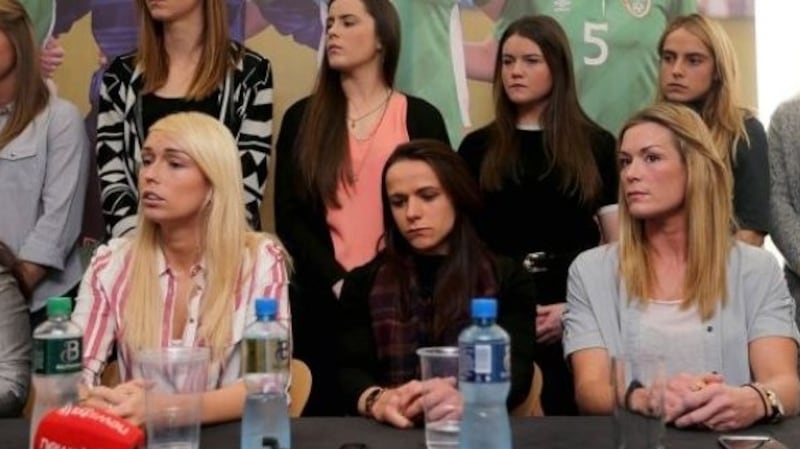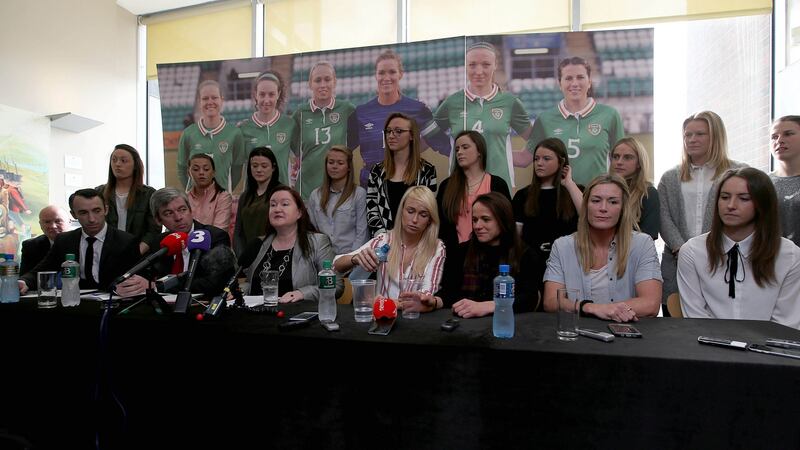At the height of the dispute between the Irish women’s squad and the FAI, an email arrived from a college coach over here. Having read about Ireland’s best being forced to tog off in airport bathrooms, this expatriate wanted to point out that upon starting life on a soccer scholarship at any serious American university, every female student athlete receives between $1,500 (€1,400) and $2,500 (€2,350) worth of personalised clothing, including tracksuits, rain jackets, winter coats, training gear, fleeces, hoodies, boots, sneakers and everything else they might possibly need for life as an elite competitor.
If that’s how amateurs who must combine playing with studying get treated across hundreds of college campuses, imagine then the disparity between life as a senior international footballer in these two countries. When the USA’s all-conquering women’s team hammered Ireland 5-0 in a friendly at Qualcomm Stadium in San Diego 15 months ago, the gulf in class on the field was even more enormous than the scoreline suggests. Equally impressive though was the difference in appearance fees. Every member of the winning team took home $1,350 (€1,270) for their day’s work. Their opponents got nothing for participating in a game that was live on American television.
We know so many interesting details about the American arrangements because five of the US women's squad have been embroiled in a wage discrimination lawsuit
Even if the FAI has now agreed to pay the Irish women €300 per appearance, their counterparts in these parts have a much more comprehensive system of benefits in place. Among many other stipulations, an agreement signed with the USSF last week entitles them to $75 per diem, direct flights when available and business class travel to international tournaments, the type of stuff Roy Keane had to battle the FAI for back in the day.
Childcare allowance
Also, players with kids get a daily childcare allowance while away on duty, the squad has five vans at their disposable during training camp, and the guaranteed availability of a chef. Minor provisions that put Emma Byrne and her comrades having to demand to stay in hotels with proper wi-fi in some context.

We know so many interesting details about the American arrangements because five of the US women’s squad have been embroiled in a wage discrimination lawsuit against their own federation since last year. They want to be compensated at the same rate as the men’s team, a bold request lent peculiar heft by the fact they are more successful on the world stage and, in many ways, more commercially viable entities back home. As the standard-bearers in the distaff game, this quintet also see themselves as in the vanguard of an international movement.
"The fact that women are being mistreated financially is, sadly, not a breaking news story," wrote Carli Lloyd, America's best player, in an op-ed column for the New York Times. "It goes on in every field. We can't right all the world's wrongs, but we're totally determined to right the unfairness in our field, not just for ourselves but for the young players coming up behind us and for our soccer sisters around the world."
It has been reported that the FAI forked out €360,000 on the women’s senior team last year. Hardly a significant budget considering the USSF spent $357,130 on their girls’ under-15 squad in the same time frame. Indeed, between groups from under-14 to under-23, the total expenditure for 2016 came to $3,222,319 (€3 million). That number doesn’t include the senior squad or the cost of medical support staff or the salaries of the coaches. It goes without saying that every American side from under-14 girls up has a full-time coach assigned to it.

Since 1991, the United States has won three women’s World Cups and four Olympic gold medals. Over the course of quarter of a century of unprecedented achievement, they’ve learned success on that scale requires a certain level of investment. The more they win on the bigger stages though, the more young girls sign up to play, the more sponsors want to get involved. Simple economics.
Market leader
Some might argue it’s unfair to compare the Irish situation with the American equivalent because this country has long been the market leader in the women’s game. This is true. However, when the Irish team is being sent over here to be cannon fodder in lucrative friendlies, surely they are entitled to ask to be treated in a somewhat similar fashion to their opponents. Then again, perhaps not, because a few in the FAI hierarchy have traditionally evinced a very curious attitude towards the game in the United States, acting almost as if there’s nothing they could learn from it.
More than one American coach of my acquaintance has spoken about prominent FAI blazers who have been openly hostile to their efforts to recruit female players from Ireland
Consider this. Every year, the French Football Federation invites American college coaches to Clarefontaine for one weekend to run the rule over the country’s best secondary school players so they can offer them scholarships. The French are rivals with the USA at senior level but understand that the opportunity of four years playing in the uber-competitive collegiate system, training in a quasi-professional environment, while simultaneously garnering a university degree, will hugely benefit their women. Whether or not they ever make it as internationals.
In stark contrast to that enlightened approach, more than one American coach of my acquaintance has spoken about prominent FAI blazers who have been openly hostile to their efforts to recruit female players from Ireland. Of course, in their defence, they might just be afraid too many women will go there and return with misguided notions about exactly how elite soccer players should be treated.












